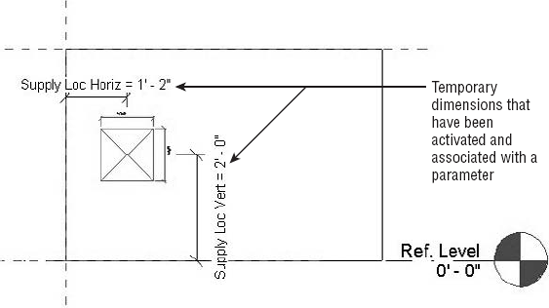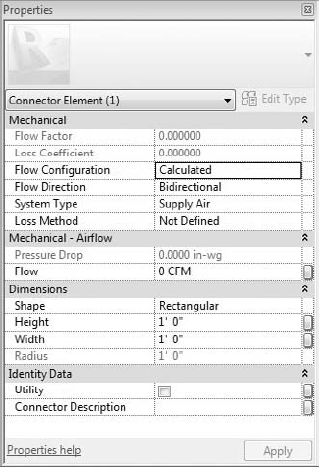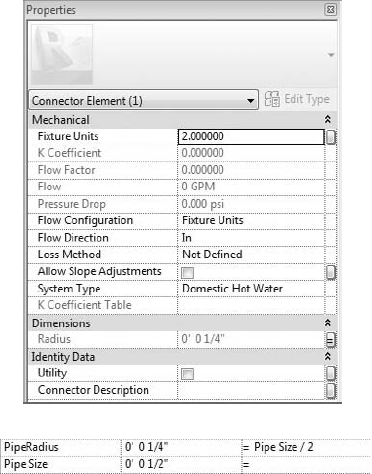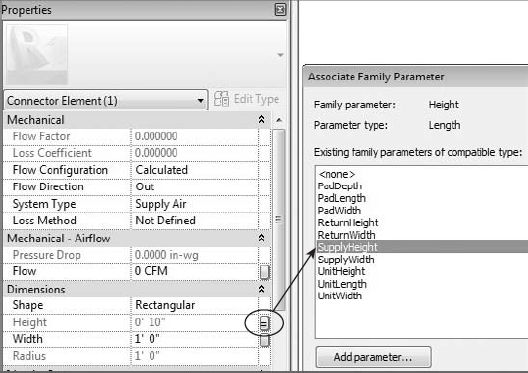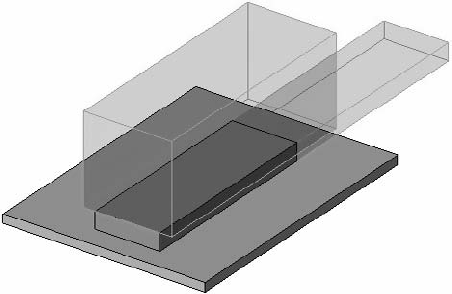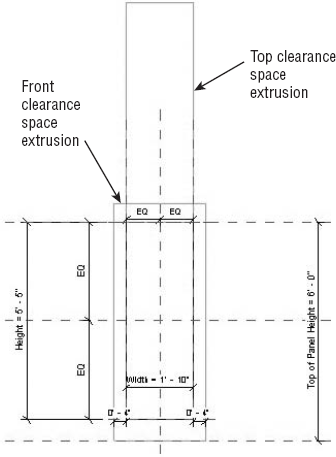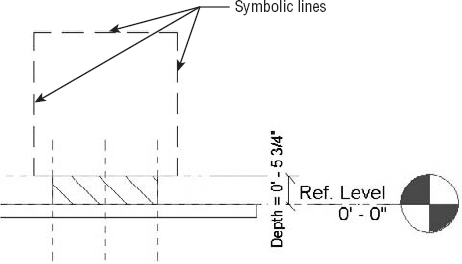The equipment families used for the design of your MEP engineering systems are important not only for coordinating the physical model but also for establishing the components that serve as the equipment for your engineering systems. The properties you assign to your equipment families will define how they can be used in relationship to other components within a system.
Many mechanical and electrical equipment items require clearance space for maintenance and installation. With Revit MEP 2011, you can define the required clearances for equipment families either directly in the family files or as a separate component. This gives you the ability to fully coordinate your model to avoid costly conflicts during construction.
Creating equipment families that are generic enough for use early on in the design process, yet parametrically changeable, will help you transition through design phases and changes to systems smoothly and efficiently. The physical properties of MEP equipment are similar enough in most cases to use simple geometry that can be sized according to specified equipment.
Whether you are creating equipment for mechanical, plumbing, or electrical systems, knowing how the equipment will be used from an engineering standpoint as well as a modeling standpoint will help you create the types of families that fit your workflow and processes best.
In this chapter, you will learn to
Create MEP equipment families
Add connectors to equipment for systems
Create clearance spaces for equipment
Add parameters to equipment
With the rising popularity of building information modeling (BIM), more and more manufacturers are providing their products for use in a virtual model environment. This can be very useful when you get to the stage in your design where you can specify the exact equipment to be used. Early in the design, however, you may not yet know what equipment will be used. Furthermore, you may not yet have done calculations that would determine the size of the equipment needed.
All of this boils down to a need for MEP equipment families that are realistic in size and function but also parametrically editable to compensate for changes in the design of both the project and the systems used. These families need to be flexible enough to handle the seemingly constant change that occurs early in the design process but also need to have the functionality to accurately represent their intended purpose.
Some of the resistance to adopting a BIM approach to designing a project is that too much information is required early on that is not known in a typical project environment. Having usable equipment families can alleviate some of that concern and allow you to move forward with your design processes.
The first thing to consider when creating an equipment family is how the family will be placed into a project model. Is the equipment in-line with duct or pipe? Does the equipment require a building element to be attached to? Knowing the answers to these types of questions will help you start with the right family type so that the equipment you create can be used properly in your projects.
Equipment that sits on the floor of a room or at the exterior of a building does not need to be created as a hosted family. When you place a nonhosted family into your project, it will be associated with the level of the view in which it is placed. However, if the equipment requires a pad for housekeeping or structural support, you may want to make the family face hosted so that it can be attached to the face of the pad. This will allow for coordination with changes to the pad, assuming that the pad is provided by the structural engineer or architect. If the equipment you are creating always requires a pad, you can build it directly in the equipment family.
Face hosted families should be used for equipment such as control equipment or panels that are typically mounted to walls or on the side of large equipment. This will save you time in making changes when walls are moved and allow you to see when changes have a negative effect on equipment location.
Once you have determined the hosting behavior of an equipment family, you can build the solid geometry of the equipment in relation to the host object or reference plane that represents how the family will be placed into a model.
There are essentially two choices for categorizing your equipment families. You can categorize an equipment family as either Mechanical or Electrical equipment. This may seem very limiting, but keep in mind that with Revit you make any family whatever category you choose. It may be necessary to categorize an equipment family as some other model category, depending on how it is used in your projects. This is typically done for visibility control or scheduling purposes.
You can set the category of a family by clicking the Family Category And Parameters button on the Home tab in the Family Editor.

When you categorize a family as Mechanical equipment, you can set its behavior with the Part Type parameter, as shown in Figure 20.1. The Normal option is for equipment that is simply placed into the model and stands on its own, while the Breaks Into option is for equipment that is in-line with ductwork or pipe. The Breaks Into option allows you to insert the family directly into a run of duct or pipe without having to first create an opening for the equipment.
The Part Type parameter for Electrical Equipment families also has options for defining the equipment behavior, as shown in Figure 20.2. These options let you define how the equipment is used in an electrical system.
If you choose the Panelboard option, you can set the configuration of the breakers and circuit numbering in the panel. This corresponds to the template used for panel schedules.

Another family parameter that you should consider is the Always Vertical option. Selecting this option will cause the equipment family to always appear vertical at 90° no matter how the host is sloped. This setting is used for hosted families. If you are creating a nonhosted family and you want to be able to place the family in any orientation, you can set the Work Plane-Based option. This allows you to place a nonhosted family onto any work plane defined in your project. Otherwise, if you place a nonhosted family into a project and it is associated with the level of the view placed, you will not be able to rotate the family in section or elevation views.
Setting the family to Work Plane-Based does not mean you can rotate the family in section or elevation, but you can create a reference plane that is at the desired rotation in the project and associate the family with that plane, as shown in the section view in Figure 20.3. When placing a Work Plane-Based family into a project, the option to place the family onto a face is available on the Placement panel of the contextual tab.
This functionality is very useful because it allows you to use nonhosted families in a face-hosted fashion.
When you are modeling your equipment families, consider the amount of detail required to represent the equipment. Mechanical components can be very complicated structures that include many intricate parts. It is not necessary to model your equipment families to a high level of detail for them to function properly in your projects. If you need to show equipment with a lot of detail, you can use model lines or symbolic lines to represent the equipment in views where the high level of detail is needed, while keeping the family geometry simple.
Most equipment families can be modeled using very simple geometric forms such as cubes and cylinders. If the equipment family you are creating requires more complex geometry, you will need to use the other modeling tools available in the Family Editor, such as the Sweep, Blend, and Revolve tools.
For instances where you only need to show the amount of space required for equipment, you can model it as a box that is visible in Coarse detail views. More detailed geometry can be modeled to show in views with a finer level of detail. The important thing with using this technique is that the connection points for ductwork or pipe should be located on the outer edges of the box geometry.
MEP discipline equipment families can include connectors for ducts, pipes, conduit, and even cable tray if necessary. These connectors are added to define the function of the equipment from an engineering standpoint. Connectors are added by one of two methods, either by placing them on a face of the solid geometry or by associating them with a work plane within the family. When you associate a connector with a work plane, it can be located anywhere in that plane. Connectors placed with the Face option on the Placement panel of the contextual tab will automatically attach to the center of the face.
Using the Face option is useful when you know that the connection point is always at the center of the geometry because if the geometry changes size, the location of the connector will adjust, or if the geometry changes location within the family, the connector will move with it. This method requires less constraint within the family for the location of the connector, but it may be necessary to model extra geometry to provide a properly located face for a connector.
Creating geometry for the location of connectors is an easy way to manage not only connector locations but also connector sizes. The size of a connector can be associated with the size of its geometry host face. This allows for accurate modeling of connection points of different family types within a family.
Geometry used for connection points may be more easily dimensioned than connectors themselves because you can dimension to the edges of geometry, where connectors can be dimensioned only to their center points. For example, if you have a rectangular duct connection that varies in size yet needs to maintain a certain distance from the edge of the unit, you can model geometry that is constrained to the dimensional requirements and host the connector to that face. Figure 20.4 shows an example of an extrusion used in this manner. The 0'-6" and 0'-4" dimensions are locked to hold the extrusion in place when the UnitHeight and UnitWidth parameters are changed and when the SupplyHeight and SupplyWidth parameters change.
Using extrusions for connection points can make it easier to identify where to connect pipes, duct, or conduit to your equipment when working with the family in a project. More information on connector geometry is provided in the next section of this chapter.
When you are creating an equipment family that requires a pad to be mounted on, it may be best to include the pad geometry directly in the equipment family. This will enable you to ensure that the proper dimensions are used for the pad without having to make any changes in another file such as a structural or architectural link. If the equipment does not always require a pad, you can control whether the pad is used with a parameter or with family types.
The key to creating pad geometry in an equipment family is to provide a reference for the top of the pad so that the equipment geometry can be modeled in the correct location and maintain a proper relationship with the pad. If you are creating a face hosted family, the pad should be modeled so that it is associated with the host extrusion, as shown in Figure 20.5.
The connectors that you add to an equipment family will ultimately determine its use in your Revit projects. Connectors can be added for the completion of air, fluid, and electrical systems when the family is selected as the system's equipment in your project.
In most cases, the location of connectors on equipment families is easily handled by geometry modeled specifically for the connector. However, it is not always necessary to have connector geometry. Some equipment families are simply used for equipment location and do not need to be modeled to any level of detail. Early on in the design of a project you may want to use "placeholder" equipment families until specified equipment can be chosen based on calculations. It is still helpful for these types of families to have connectors so that duct, pipe, and conduit can be connected and system analysis can be performed.
If you do not need extra geometry to define the location of a connector, you can dimension directly to the connector by selecting it and then activating the temporary dimension to the center of the connector. Once activated, you can associate the dimension to a parameter. This can be done only if you use the Work Plane option for placing the connector. Using the Face option constrains the connector to the center of the face so its dimensions cannot be manually changed. Figure 20.6 shows how a Work Plane–placed connector location can be dimensioned and parametrically managed.
In this example, if you want to keep the right and bottom edges of the connector static when the connector changes size, you would need to write a formula for the connector dimension parameter. For example, with a parameter that defines the connector width, such as SupplyWidth, the left edge of the connector can be made to stay at 0'-8" (200mm) from the left edge of the equipment by using a formula for the Supply Loc Horiz parameter, as shown in Figure 20.7.
When you have equipment that has several pipe connectors, it is helpful to create geometry for the connectors. Otherwise, you would have to define a reference plane for each connector unless they all connected at the same plane. With geometry used for a connector, you can dimension and constrain the geometry and then use the Face option for connector placement. This does not eliminate the need for dimensions or constraints; it only takes them off the connector object itself.
When you sketch a circle to create a cylinder, the point at which you draw the center can be dimensioned while you are in sketch mode. This dimension can be used for the location of the connector, as shown in Figure 20.8. The radius of the sketch can also be dimensioned and associated with a parameter for easy size adjustment.
With the geometry in place, a connector can be added using the Face option for placement, as shown in Figure 20.9. You can adjust the connector properties to associate the size of the connector with the parameter created for the geometry radius.
Using the Face option is the easiest way to place connectors into a family. The direction of the connector can be easily flipped using the blue arrows grip that appears when you select the connector. The direction arrow of a connector indicates the direction that pipe, duct, conduit, or cable tray will be drawn from the connector. The drawback to using the Face option is having to create additional geometry if the location of a connector needs to be parametrically managed.
Connectors that are placed using the Work Plane option may not be facing the right direction when you place them. The blue arrows grip will not work to flip the direction, so you will have to rotate the plane that the connector is associated with or redraw it in the opposite direction. The benefit of using the Work Plane option is that you can locate a connector anywhere on the plane.
The decision to use the Face or Work Plane option for connectors depends on how you want to control the location of the connector. Whatever method you choose, once a connector is placed, you can adjust its properties so that the equipment family will behave as desired in your projects.
You can select the system type of a duct connector from the Options Bar when you click the Duct Connector button on the Home tab in the Family Editor.

The Global option will enable creating air systems depending on flow direction when the family is used in a project. A Global connector with a flow direction of In will enable a Supply system to be created, while Out can be used for Return or Exhaust. Bidirectional flow gives you options for Supply, Return, and Exhaust. Fitting connectors do not have parameters to define air system behavior and are typically used on duct fitting families to establish connectivity.
For air systems equipment, your duct connectors should be set with the properties that coincide with the behavior of the equipment that the family represents. Figure 20.10 shows the properties of a duct connector selected that has just been added to a family.
- Flow Configuration
The Flow Configuration parameter is used for setting how the flow is determined at the connector point.

- Calculated
This option will add up all the flow values from objects downstream in the system.
- Preset
This option is for direct input of the flow value at the connector point.
- System
This option can be used if the flow at the connector point is a percentage of the entire flow for a system. With the System option, you will have to provide a value for the Flow Factor parameter. For example, if the equipment you are creating is used in a system with other equipment in your project and it provides 30 percent of the flow, the Flow Configuration would be set to System, and the Flow Factor would be set to 0.33.
- Flow Direction
The Flow Direction parameter is used to define the direction of the air at the connector point.
- Loss Method
The Loss Method parameter allows you to assign either a Coefficient, by placing a value in the Loss Coefficient parameter, or a Specific Loss by placing a value in the Pressure Drop parameter. Keep in mind that these values are for the selected connector. If you have additional connectors in the family, you can assign unique values to them also.
- Shape
Use the Shape parameter to define the connector as round or rectangular. The dimensions of a connector can then be assigned in the connector properties. Placing values for the Height, Width, or Radius of a connector will set the size of duct drawn from that connector. If you want to change the size of the connector in the family properties, you can associate its dimensions with parameters created in the family, as shown in Figure 20.11.
- Utility
The Utility parameter for a connector is used to define whether the connector indicates a utility connection. This allows for coordination when your project is exported for use in Autodesk Civil 3D. The connection points defined as utilities will be available in the exported file for coordination of things such as service entrance locations and invert elevations.
The dimensions of a connector can be associated to a parameter by clicking the + sign grip that appears near the connector label when the connector is selected in a view.

It is important to establish the orientation of the Width and Height dimensions of a connector on your equipment. Otherwise, duct or duct fittings that are connected to the connection point may not be oriented properly. You can rotate a connector placed with the Face option by clicking and dragging it; however, this is an inaccurate method of rotation. Using the Rotate tool allows you to set a specific angle of rotation. If you use the Pin tool to lock the location of a connector, you will also not be able to rotate it. This can be useful if you find that you are accidentally clicking and dragging the rotation of your connectors when working in the Family Editor.
Connectors for pipes can be placed on your equipment families in the same manner as duct connectors. You can find options for setting the system type on the Options Bar when you click the Pipe Connector button on the Home tab in the Family Editor.

The properties for a pipe connector are similar to that of a duct connector except that they deal with the flow of liquid instead of air. Because liquid flows differently, there are some different choices for the same parameters you would find in a duct connector.
- Flow Configuration
The Flow Configuration for a pipe connector has options depending on the system type. Systems related to plumbing pipes have an additional Flow Configuration option called Fixture Units. This establishes that the flow at the connector is based on the value given to the Fixture Units parameter, as shown in Figure 20.12. Notice that the Flow parameter is not active when using the Fixture Units option for Flow Configuration.
- Radius
The size of the connector is determined by the Radius parameter. Unless the connector does not need to change size with different family types, you should associate the Radius parameter with a family parameter for easy editing. Since pipe sizes are usually given as the nominal diameter of the pipe, you can also create a parameter for pipe size and use a formula to derive the radius from the size given. That way, your input is consistent with industry standards.
- Allow Slope Adjustments
The Allow Slope Adjustments parameter lets you establish whether pipe attached to the connector can be sloped. If you do not select the box, then when you apply a slope to pipe that is connected to the connector, you will receive an error message that the angle between the elements is too great, and the pipe will become disconnected from the equipment.
If you draw sloped pipe from a connector that allows for slope adjustment, the Pipe Connector Tolerance angle defined in the MEP settings of your project will determine the maximum angle that a sloped pipe can enter a connector. If the angle is exceeded, a straight run of pipe and an elbow fitting will be drawn from the connector prior to the sloped pipe.
There are three kinds of connectors for electrical systems: conduit connectors, cable tray connectors, and electrical connectors.
- Conduit connectors
These can be added by clicking the Conduit Connector button on the Home tab in the Family Editor. The Options Bar provides the two choices available for conduit connectors.

- Individual connector
This option is for placing a single connection point in a specific location on the equipment. These connectors have properties for adjusting the angle and setting the radius of the connector.
- Surface connector
The surface connector is a unique and powerful option because it allows you to establish an entire surface of the equipment geometry as a connection point for conduit. Figure 20.13 shows a conduit surface connector that has been added to the top of an electrical panel family. This allows for the connection of multiple conduits at any location on the top of the panel. The Angle parameter can be set to allow for adjustments in the angle of the surface that the connector is attached to. This parameter is typically used in fitting families but may have application in an equipment family.
When an equipment family with a surface connector is used in a project, conduit can be drawn to or from the surface using the Conduit tool on the Home tab. The surface containing the connector will highlight when you place your cursor over it. Selecting the surface will activate the Surface Connection mode, which allows you to drag the connector location to any point on the surface. This process can be repeated several times for the same surface connector, allowing you to model multiple conduits from your equipment, as shown in Figure 20.14. See Chapter 13 for more information on modeling conduit.
- Cable tray connector
The Cable Tray Connector button on the Home tab in the Family Editor allows you to place a point of connection for cable tray. These connectors are similar to the individual conduit connector, having properties for the angle and for setting the height and width of the connector.
- Electrical connector
Clicking the Electrical Connector button on the Home tab in the Family Editor allows you to place a point of connection for wiring, which will also define what type of system the equipment can be used in. The Options Bar allows you to define the system of the connector prior to placement.
Many of the properties for an electrical connector can be associated with family parameters for easy management and creation of family types. The Voltage parameter will determine what distribution systems in your project the equipment can be used in, which must be coordinated with the value of the Number Of Poles parameter. The Load Classification parameter enables you to assign a load classification to the connector that will determine the demand factor when used in a project. If you create a new load classification in the family, it will be available in the project when the family is loaded.
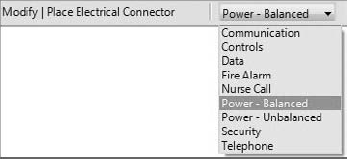
Many MEP equipment families have multiple types of connectors. Your work environment may determine the connectors that you add to equipment families. For example, if your projects contain all MEP systems in one model, you may want to have electrical connectors in your HVAC equipment families that require electricity. If you have a separate model for each discipline, there is no need to have an electrical connector on any mechanical equipment families because the connection cannot be made through a linked file.
It is possible to link connectors in a family. This is useful for when you want the system behavior to pass through from one connector to the other, such as when you have an air systems equipment family that has a connector with supply air flowing into the equipment and a supply air connector with air flowing out. Linking the connectors propagates system information through the equipment, so air flow in is related to air flow out of the equipment. You can link connectors by selecting one of the connectors and clicking the Link Connectors button on the Connector Links panel.

Linked connectors will take on the Flow Configuration value of the primary connector. So even if you have a connector in the family that has a Flow Configuration set to Preset, if it is linked to a primary connector set to Calculated, the behavior of the connector when in a project will be as if the connector is set to Calculated. You can tell whether connectors are linked in a family by selecting one of the connectors in the Family Editor. Red arrows will appear between the connector and the one it is linked to, as shown in Figure 20.15.
The primary connector in a family is the first connector of each type added to the family and is indicated by crosshairs in the connector graphics. Figure 20.16 shows an equipment family with multiple types of connectors. You can change which connectors are the primary ones by clicking the Re-assign Primary button that appears on the Primary Connector panel of the contextual tab when you select a connector. Clicking the button allows you to select another connector, which will become the primary for that type.
Naming connectors in a family makes it easier to understand which one you are connecting to when working in a project. The Connector Description parameter in a connector's properties is where you can name the connector. When using the Connect Into tool in a project on a family with multiple connectors, the connectors will appear in a list with their descriptions so you can choose the proper one.
Now that you have learned some ideas about creating an equipment family, practice some of the basic skills by completing the following exercise. No matter what your discipline of expertise, the steps in this exercise will help you become more familiar with the process of creating equipment families.
Open the
Ch20_equipment.rfafile found atwww.wiley.com/go/masteringrevitmep2011.In the Ref. Level view, the intersection of the reference planes will be the corner of the equipment pad. Create a vertical reference line to the right of the vertical plane and a horizontal reference line above the horizontal plane. These lines will be used to define the length and width of the pad.

Create a dimension from the vertical reference plane to the vertical reference line. Select the dimension, and click the Label drop-down on the Options Bar. Select the <Add parameter...> option. In the Parameter Properties dialog box, name the parameter PadLength. Set the parameter to an instance parameter. Click OK. Repeat the process for the horizontal reference line, using PadWidth for the parameter name.
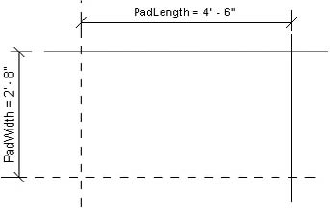
Open the Front elevation view. Draw a horizontal reference plane above the Ref. Level. Select the plane, and name it TopOfPad in its element properties. Create a dimension from the Ref. Level to the horizontal plane. Create an instance parameter for the dimension called PadDepth.

Open the Ref. Level view. Click the Extrusion button, and sketch a rectangle. Align and lock the sketch lines to the reference lines and planes. Click the green check button to complete the sketch. Open the Front elevation view. Align and lock the top of the extrusion to the TopOfPad reference line.
Click the Family Types button on the Properties panel of the Home tab. Create a Yes/No Instance parameter called Pad, grouped under Graphics. Create another parameter with the same settings called No Pad. Click OK to exit the Family Types dialog box.

Open the Ref. Level view. Create a vertical reference plane 4″ to the right of the vertical plane. Create another vertical plane 4″ to the left of the vertical reference line drawn in step 2. Create a horizontal reference plane 4″ above the horizontal plane and another 4″ below the horizontal reference line drawn in step 2.

Dimension between the two vertical planes drawn in step 7, and create an instance parameter for the dimension called UnitLength. Repeat the process for the two horizontal planes drawn in step 7, with UnitWidth as the parameter name. Add a dimension for the 4" distance from the initial vertical plane and the vertical plane drawn in step 7. Repeat the process for the 4" distance between the initial horizontal plane and the one drawn in step 7. Be sure to lock the dimensions using the padlock grip that appears when the dimension is placed.
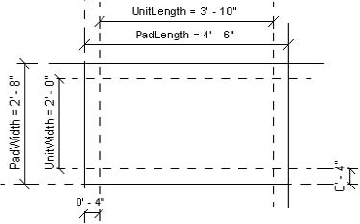
Click the Set button on the Work Plane panel of the Home tab. Select the TopOfPad reference plane from the Name drop-down list in the Work Plane dialog box. Click OK.
Click the Extrusion button, and sketch a rectangle. Align and lock the sketch lines to the reference planes drawn in step 7. Click the green check button on the Mode panel to finish the sketch.
Open the Front elevation view. Draw a reference plane from left to right above the extrusion created in step 10. Name the reference plane TopOfUnit. Add a dimension between the TopOfPad reference plane and the TopOfUnit plane. Create an instance parameter for the dimension called UnitHeight. Align and lock the top of the extrusion created in step 10 to the TopOfUnit plane.

Click the Family Types button on the Properties panel on the Home tab. Create an instance parameter called SupplyHeight and one called SupplyWidth, using the settings shown here. Give each of the parameters a value of 10″.

Repeat step 12, creating parameters called ReturnHeight and ReturnWidth. Click OK to exit the Family Types dialog box.
Open the default 3D view. Click the Duct Connector button on the Home tab. From the drop-down on the Options Bar, select Supply Air for the system. Place your cursor at an edge of the top extrusion to highlight the end face. You can use the Tab key if the desired face will not highlight when your cursor is on one of its edges. Click to select the face, and place the connector.
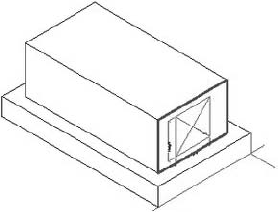
Rotate the view to show the opposite end of the extrusion. From the drop-down on the Options Bar, set the system type to Return Air. Select the face opposite from the Supply Air connector, and click to place the connector.

Click the Modify button or use the Esc key to finish placing connectors. Select the Supply Air connector, and access its element properties. Confirm that the Flow Configuration parameter is set to Calculated. Set the Flow Direction parameter to Out. Click the small rectangle to the far right of the Height parameter to associate it with the SupplyHeight family parameter, as shown in Figure 20.17. Click OK to close the Associate Family Parameter dialog box.
Associate the Width parameter of the Supply Air connector to the SupplyWidth family parameter. Click OK.
Select the Return Air connector in the view, and access its element properties. Set the Flow Configuration parameter to Preset. Set the Flow Direction parameter to In. Associate the Height and Width parameters to the ReturnHeight and ReturnWidth family parameters.
Select the Supply Air connector. Click the Link Connectors button on the Connector Links panel of the contextual tab. Click the Return Air connector. Click either of the connectors to confirm they are linked by the display of arrows between them. With a connector selected, click the Remove Link button on the Connector Links panel of the contextual tab. The arrows will disappear when the link is removed.
Click the Electrical Connector button on the Home tab. From the drop-down list on the Options Bar, set the system type to Power – Balanced. Place the connector on one of the side faces of the equipment extrusion. Click the Modify button or use the Esc key to finish placing connectors.
Select the electrical connector, and access its element properties. Set the Number Of Poles parameter to 3. Set the Load Classification parameter to HVAC by clicking the small box that appears in the value cell and choosing HVAC from the Load Classifications dialog box.
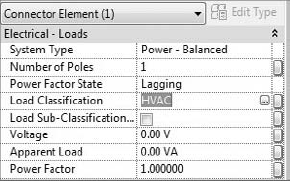
Click the small rectangle to the far right of the electrical connector's Voltage parameter to associate it with a family parameter. Since no family parameter is available, click the Add Parameter button at the bottom of the Associate Family Parameter dialog box. Create an instance parameter named UnitVoltage. Because the Voltage parameter was selected, the other properties of the parameter are already selected. Click OK to close the Parameter Properties dialog box. With the UnitVoltage parameter highlighted in the list, click OK to close the Associate Family Parameter dialog box.
Repeat step 22 for the Apparent Load parameter of the connector. Name the family parameter UnitLoad.
Click the Family Types button on the Properties panel of the Home tab. Set the value of the UnitVoltage parameter to 480. Set the value of the UnitLoad parameter to 5000. Click OK to close the dialog box. Select the electrical connector in the view, and access its element properties. Confirm that the values have been associated to the connector parameters.
You can save this family and use it to practice techniques for creating equipment. Load the family into a test project to test its behavior and usability.
Most MEP equipment requires some sort of clearance space for safety or maintenance reasons. Modeling the clearance spaces directly in your equipment families is useful for model coordination. Because the space is part of the family, any objects encroaching on the space will show up when you run an interference check of your model. You can choose to keep the spaces visible during modeling for visual reference to avoid such interferences. Even if you choose to turn the visibility of the spaces off, any interferences will still be detected.
Figure 20.18 shows an electrical panel family with clearance spaces modeled for the front of the panel and the space above the panel.
You can create clearance spaces by modeling an extrusion in the family that is associated with a reference plane at the appropriate face of the equipment. You can use other reference planes to control the size of the clearance space and constrain it to the equipment. In the example of the electrical panel, reference planes were created to constrain the top of the panel so that the front clearance space will always be 6" above the top of the panel. The dimension for the space height was done in the extrusion sketch, as shown in Figure 20.19, which shows the plan view of the face-hosted family.
Once you have modeled a clearance space extrusion, there are properties you can apply to it for visibility. In the panel example, a unique material type was created and applied to the extrusions for their semitransparent display. This keeps them from blocking out the actual equipment when shown in a model view.
A subcategory was created for the clearance space extrusions so that they can be turned off in model views without turning off the equipment category. The subcategory is given a color for the edge lines of the clearance space extrusions to stand out from other solid geometry.

Although having solid geometry in an equipment family to represent clearance spaces is useful for interference coordination, you may not want to have the solid geometry displayed in plan views. Model or symbolic lines can be used to represent the clearance space for plan views. The visibility of these lines can be controlled by a Yes/No type parameter or by a subcategory. Figure 20.20 shows clearance space lines in the Front elevation view of the panel family. The lines exist in the Front elevation view so that they will be visible in plan views when the panel is attached to a vertical host.
Another option for adding clearance spaces to your equipment is to create unique clearance space families. These families should be categorized as Mechanical or Electrical equipment families, but you could categorize them as any of the available subcategories depending on how you want to control their visibility. In a project file with worksharing enabled, a workset could be created for equipment clearance spaces, allowing for easy visibility control. There is a downside to using worksets for visibility control, however. Worksets cannot appear in a view template.
Clearance space families can be face hosted families for easy attachment to the solid geometry of your equipment families. Consider making individual families with the dimensions for each unique type of clearance or for specific types of equipment.
The key to having equipment families that are usable in the early stages of your designs is to have families that are easily modified to meet the demands of frequent changes to your project model. Using parameters gives you the flexibility to change not only the size of equipment but also the values for connectors.
Most equipment can be defined by three simple dimensions: length, width, and height. By using these parametrically, you can be confident that your equipment families occupy the space required for them in the model even if they do not look exactly like the object they represent. Be consistent with your use of and naming of these parameters. They do not need to be shared parameters unless the information is to be included in schedules, but you could create them as shared parameters for consistent naming. Because there may be other dimensions in your families, it is best to give these parameters a descriptive name, such as Unit Length or Equipment Width, to distinguish them as the overall size. Of course, having these parameters in your families is not enough; you need to have the family geometry associated to them.
MEP equipment schedules vary in size and information not only from one company to another but even in the same company, depending on the project standards or client demands. Mechanical equipment schedules are particularly difficult to manage without the proper use of parameters in your equipment families. The use of shared parameters is necessary for scheduling the systems information required from equipment schedules. The problem is that all mechanical equipment families are in one category.
To avoid having families with unnecessary parameters, it may be best to apply your shared parameters directly in the equipment families instead of using project parameters. That way, you can be sure that you have only the parameters required for scheduling of the specific families in your mechanical equipment schedules.
Connectors have parameters that you may need to change based on the performance of your engineering systems. Creating parameters in your families that the connector parameters can be associated to allows you to change the connector values without having to open, edit, and reload your families. The main thing to remember when creating these parameters is that they must match the units of the connector parameter in order for them to be associated. For example, you cannot associate a connector's Voltage parameter with a number or integer parameter.
For more information on parameters and schedules, see Chapter 19 and Chapter 5.
- Create MEP equipment families
The ability to create the types of equipment families needed for accurate modeling of components and systems is a major factor in the success of your Revit projects.
- Master It
MEP equipment can be quite complex in its structure. Complex geometry can have an adverse effect on model performance. What are some ways to model equipment in the most simple form yet still convey the proper information on construction documents?
- Add connectors to equipment for systems
Adding connectors to equipment families will make them functional for use in the design of engineering systems.
- Master It
It is important to know how your equipment families will be used in your projects from an engineering standpoint as well as for model coordination. Explain how connectors determine the behavior of an equipment family.
- Create clearance spaces for equipment
Space for safety and service of equipment is crucial to building design. The ability to coordinate clearances around equipment improves project quality and can reduce construction and design cost.
- Master It
Equipment families with built-in clearance spaces allow you to quickly and easily determine whether the equipment will fit into your project model. Describe some options for controlling the visibility of clearance spaces so that they are not shown when not needed.
- Add parameters to equipment
Parameters in your equipment families can be useful for creating schedules in your Revit projects that report data directly from the equipment used in the design. Family parameters can enable you to make equipment families that are changeable without having to create new families.
- Master It
Shared parameters must be used in your equipment families if you want to schedule the data they provide. If you are creating parameters for parametric behavior of the solid geometry, do they also need to be shared parameters?






